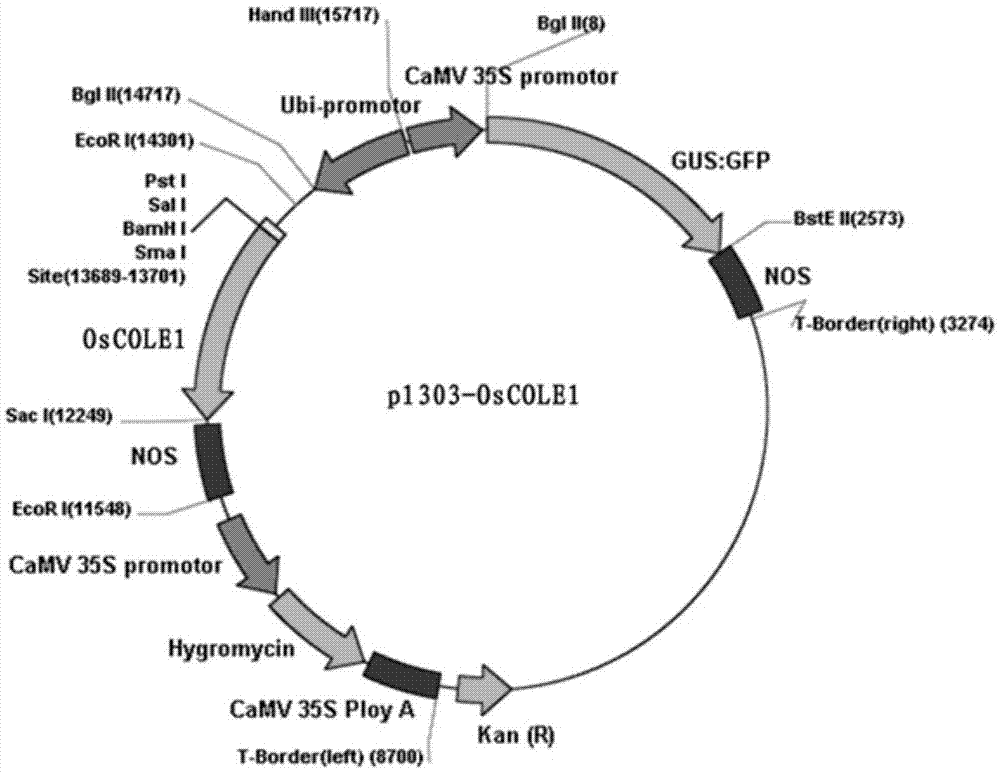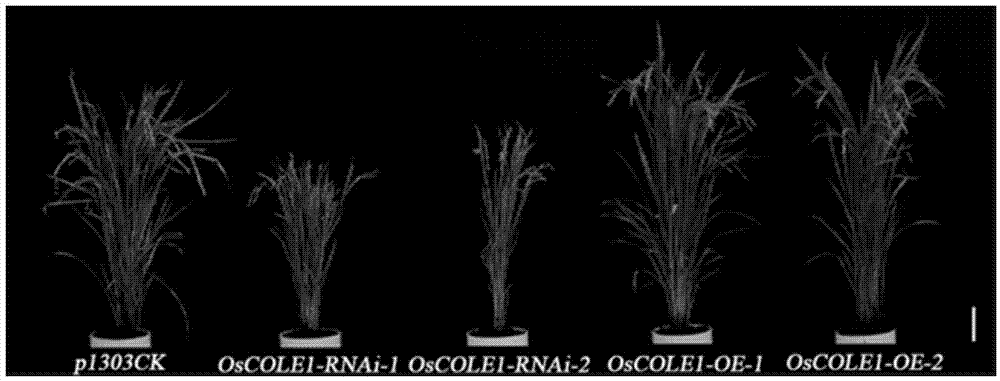Auxin regulation protein, coding gene thereof, and application of protein and coding gene
A technology for regulating proteins and encoding genes, which is applied in the fields of application, genetic engineering, plant genetic improvement, etc.
- Summary
- Abstract
- Description
- Claims
- Application Information
AI Technical Summary
Problems solved by technology
Method used
Image
Examples
Embodiment 1
[0019] Example 1 Cloning of OsCOLE1 gene cDNA
[0020] 1.1 RNA extraction and DNA removal:
[0021] 1) About 200 mg of Nipponbare seedlings were taken as material, ground with liquid nitrogen, and RNA was extracted with Trizol reagent (Invitrogen).
[0022] 2) Dissolve RNA in 85 μl of water, add 10 μl of 10× buffer and 5 μl of RQ1 RNAFree DNase (1 U / μl), at 37° C. for 15 minutes to remove DNA contamination.
[0023] 3) Add 100 μl of phenol-chloroform for extraction once, take the supernatant, precipitate RNA with an equal volume of isopropanol, wash once with 70% ethanol, and dissolve in 50 μl of water.
[0024] 4) The concentration of quantitative RNA is 1 μg / μl.
[0025] 1.2 Reverse transcription:
[0026] Follow Promega's GoScript TM Reverse Transcription System (PromegaA5000) kit was carried out, and the reaction procedure was as follows:
[0027] 1) Add the following reagents in turn, mix well and react:
[0028]
[0029] 2) After the above reaction finishes, add...
Embodiment 2
[0059] The acquisition of embodiment 2 transgenic rice
[0060] 2.1 Induction culture of rice mature embryo callus
[0061] Ripe rice Nipponbare seeds are soaked in 75% ethanol for 1-2 minutes after removing the chaff. After removing ethanol, add 0.1% mercuric chloride solution to soak the seeds for 30min (shake regularly during the period). Remove the mercuric chloride solution and rinse the sterilized seeds 3-4 times with sterile water. After the seeds were placed on sterile filter paper to absorb water, they were transferred to mature embryo callus induction medium and cultured in the dark at 26°C for about 2 weeks. Carefully remove the callus grown from the scutellum of the mature embryo, and transfer it to the subculture medium of the mature embryo. Subculture under the same conditions. Calli were subcultured every two weeks. Select subcultured 5-7d calli with pale yellow color for co-cultivation.
[0062] 2.2 Preparation of Agrobacterium Transformant Infection Solu...
Embodiment 3
[0072] Identification of embodiment 3 transgenic rice
[0073] 3.1 Extraction of DNA:
[0074] 1) Cut 100mg leaves of the transgenic material, freeze them quickly in liquid nitrogen, transfer them to a mortar filled with liquid nitrogen, grind them, and transfer the powder to a 1.5ml centrifuge tube;
[0075] 2) Add 600 μl of SDS solution, mix by inverting, place in a water bath at 65°C for 60 min, and mix by inverting every 15 min);
[0076] 3) Add an equal volume of chloroform: isoamyl alcohol (V:V=24:1), mix gently by inversion, let stand for 5 minutes, and centrifuge at 12000 rpm for 15 minutes;
[0077] 4) Transfer the supernatant to another new centrifuge tube, add an equal volume of isopropanol, mix evenly by inversion, let stand for 5 minutes, and centrifuge at 12000 rpm for 15 minutes;
[0078] 5) Discard the supernatant, wash the precipitate with 75% ethanol, dry, add 30 μl sterile water to dissolve the DNA (RNase is added to the sterile water to remove RNA), and s...
PUM
 Login to View More
Login to View More Abstract
Description
Claims
Application Information
 Login to View More
Login to View More - R&D
- Intellectual Property
- Life Sciences
- Materials
- Tech Scout
- Unparalleled Data Quality
- Higher Quality Content
- 60% Fewer Hallucinations
Browse by: Latest US Patents, China's latest patents, Technical Efficacy Thesaurus, Application Domain, Technology Topic, Popular Technical Reports.
© 2025 PatSnap. All rights reserved.Legal|Privacy policy|Modern Slavery Act Transparency Statement|Sitemap|About US| Contact US: help@patsnap.com



